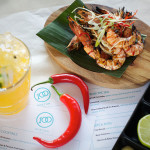Asian-fusion food – the low down

 From scrumptious seafood dishes to spicy noodle soups, Asian cuisine is known for its use of exotic spices and herbs, many of which can now be found in the supermarket, as well as Asian speciality shops.
From scrumptious seafood dishes to spicy noodle soups, Asian cuisine is known for its use of exotic spices and herbs, many of which can now be found in the supermarket, as well as Asian speciality shops.
Asian fusion food typically takes Asian flavours or dishes and merges them with local ingredients, including fresh fruit and vegetables. If you really enjoy Asian-fusion food – as found in Shoreditch restaurants such as 100 Hoxton and elsewhere in London at Gilgamesh — then you might enjoy this overview, brought to you by the folks at 100 Hoxton.
Southwest
India’s myriad cuisines provide the dominant flavours of South-West Asia, although Nepal, Bangladesh and Pakistan also have plenty to offer. Breads include naan, chapati, roti, but Indian cuisines vary widely. Spices are typically, though not always, used dried and freshly ground, sauces tend to be thicker rather than lighter, and thanks to a strong vegetarian trend within the region, lentils and beans feature highly. Rice, particularly basmati, is famous.
North-East
Chinese cuisine is incredibly diverse, with wide variations from north to south, but one flavour you’ll find through much of Chinese cooking is the spice mix known as five spice. Pickles feature heavily in Chinese, Korean and Japanese cooking, as does barbecuing and grilling, whether in Japanese farmhouse style cooking, the world-famous Korean barbecue or its lesser-known Chinese sibling.
South-East
Vietnam and Thailand are probably the two most famous cuisines of South-East Asia, although the native fusions found in Malaysia and Singapore are also influential. Their food is typically light, healthy and uses lots of fresh vegetables, as well as fresh herbs (think of the Vietnamese pho, garnished with stacks of different herbs) and fresh spice pastes, such as the base for tom yam soup and similar, along with citrus flavours. Herbs such as kaffir lime, various basils, and roots such as ginger, galingale and fresh turmeric feature highly.
The Fusion Deal
The prevalence of spices in Asian cuisines make them remarkably easy to adapt to another culture – think of a Thai rare beef salad made with local lettuce and vegetables but Thai herbs and spices. Or a Japanese green tea icecream served with a plum sauce – two distinctly Japanese flavours treated in a very Western way.
At its simplest, Asian fusion is the use of distinctly Asian flavours – be that five spice, Sichuan pepper, star anise or kaffir lime – to transform a dish. You’ll also find fusion cocktails, utilising flavours such as rose water, or tropical fruits such as lychee, mango or tamarind.